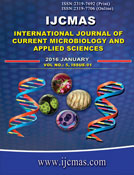


 National Academy of Agricultural Sciences (NAAS)
National Academy of Agricultural Sciences (NAAS)

|
PRINT ISSN : 2319-7692
Online ISSN : 2319-7706 Issues : 12 per year Publisher : Excellent Publishers Email : editorijcmas@gmail.com / submit@ijcmas.com Editor-in-chief: Dr.M.Prakash Index Copernicus ICV 2018: 95.39 NAAS RATING 2020: 5.38 |
Infection with resistant organisms is a major public health issue. Evolution of resistance to beta lactam antibiotics in Gram negative pathogens, especially E.coli, frequently results from the production of B-lactamase enzymes able to hydrolyze B-lactam ring. The aim of this study was to detect the different types of resistance in Gram-negative bacilli to understand the disease burden and the antimicrobial susceptibility pattern. In addition we aimed to formulatean effective antibiotic strategy and to be the basis for a proper infection control strategy to prevent the spread of these stains .A total of 141 Gram negative bacilli isolates were identified and processed for the detection of ESBL, AmpC and Carbapenemase production using various methods according to Clinical Laboratory Standards Institute. Out of 141 Gram negative bacilli; E. coli and Klebsiella pneumoniae were the commonest two organisms identified (79.4% and17.7% respectively) and 27.7%, 3.5% and 0.7% showed the presence of ESBL, AmpC and Carbapenemase respectively. Among E. coli 32/112 (28.6%) were ESBL producers compared to 6/25 (24%) in Klebsiella pneumoniae and 1/1 (100%)in Pseudomonas aeruginosa with statistically insignificant difference (P=0.55). Among E. coli 4/112 (3.6%) were AmpC producers and 1/1(100%) in Enterobacter Cloacae witha highly significant statistical difference (P=0.000). All ESBL and AmpC producing isolates were sensitive to Ertapenem, Imipenem, Meropenem and Amikacin. Carbapenemase producing organisms were resistant to all antibiotics except Gentamicin and Fosfomycin. From our results we can conclude that ESBL producers are increasing in the patients visiting primary healthcare clinics. So, routine ESBL detection should be mandatory done. The different antimicrobial resistance patterns of GNB must be taken in consideration by local physicians to ensure appropriate empiric use of antibiotics and hopefully help in treatment of CA-acquired infections.
 |
 |
 |
 |
 |